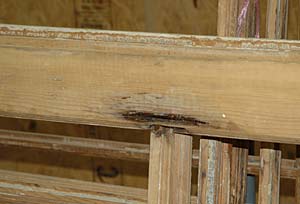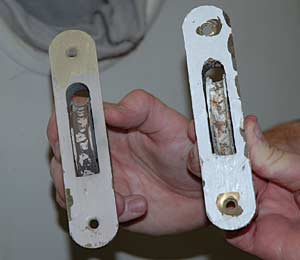|
Thomas Jefferson's classical temple-form
capitol building, completed in 1788, and added
to from 1904 to 1906, has a total of 104 windows.
The largest window is approximately five feet
wide and 14 feet tall. According to James W. Dossett,
architectural conservator with Hillier Architecture,
the initial survey indicated that despite peeling
paint and ordinary wear and tear, the windows
were in good condition and could be restored.
The repair process involved several steps.
 |
Decayed
sash join will get repaired with epoxy, Virginia
State Capitol
Photo courtesy of HillierArchitecture |
First, the sashes and all hardware were removed
on site, tagged with the window number, and then
shipped to a restoration shop in Kansas City.
Once in the shop, the sashes were stamped with
a permanent identification number and sorted.
Those needing more substantial repairs were pulled
aside.
Then, the sashes were stripped to bare wood.
The frames were racked slightly to allow glue
to be injected into the mortise and tenon joints.
Muntins were routed to receive the thicker laminated
glass. Dutchman repairs, a term that applies to
cutting out a small area of damaged or decayed
material and inserting and gluing a new piece
of the same material, were made to large areas
of decayed or damaged wood. Epoxy repairs were
made for small fills and consolidation of damaged
wood. Sanding, priming, spackling, more sanding,
and a second priming coat were applied. A finish
coat of paint was applied to match the 1906 color,
as determined by historic paint analyst Frank
Welsh.
 |
Brass sash
pulley on left has been partially cleaned,
Virginia State Capitol
Photo courtesy of HillierArchitecture |
All windows were fitted with new laminated low-iron
glass, including two layers of one-eighth-inch
glass with a clear polyvinyl butyral (PVB) interlayer.
The use of insulated glass was rejected because
its thickness would have required removing too
much of the existing muntins. The laminated glass
has better thermal properties than single glazing
and is better at reducing sound transmission.
Also, the clear plastic interlayer cuts ultraviolet
(UV) transmission, which is very important for
the maintenance of historic artwork and furnishings.
Low iron glass was selected because ordinary glass
has a greenish tint.
The sashes were shipped back to the site and
re-installed with all new bronze weather-stripping.
The wood frames were stripped to bare wood, and
repaired prior to repainting. The original wood
sills were clad in copper. Probes indicated that
the wood was in good condition, and the copper
was repaired in place and painted. All hardware
was re-used, cleaned and re-furbished. New sash
weights were added to compensate for the additional
weight of the laminated glass.
|